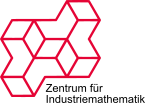Prof. Dr. Dr. h.c. Peter Maaß
Leiter der AG TechnomathematikRaum: MZH 2250
E-Mail: pmaass@math.uni-bremen.de
Telefon: (0421) 218-63801
ORCID iD: 0000-0003-1448-8345
E-Mail: pmaass@math.uni-bremen.de
Telefon: (0421) 218-63801
ORCID iD: 0000-0003-1448-8345
Lebenslauf
| 26.10.59 | geboren in Karlsruhe |
| 1979-81 | Mathematik-Studium an der TH Karlsruhe |
| 1981-82 | Pembroke College, Cambridge, England (DAAD-Stipendium) |
| 1982-85 | Studium an der Universität Heidelberg |
| 5.6.1985 | Diplom in Mathematik (Diplomarbeit bei Prof. Dr. E. Hairer) |
| 1985-87 | Mitarbeiter im DFG-Projekt (Prof. Dr. A.K. Louis) "Entwicklung effizienter Algorithmen für die Computer-Tomographie" |
| 1987-90 | wissenschaftlicher Mitarbeiter am Fachbereich Mathematik TU Berlin |
| 3.2.1988 | Promotion in Berlin |
| 1990-91 | Assistant Professor, Tufts University, Boston (Tomographie Arbeitsgruppe: A. Cormack, E.T. Quinto), 1990-1991 |
| 1991-93 | Hochschul-Assistent, Universität Saarbrücken |
| 21.5.1993 | Habilitation in Saarbrücken |
| 1993-99 | Professur (C4) für Numerische Mathematik in Potsdam |
| 1999-2021 | Professur (C4), Direktor des Zentrums für Technomathematik in Bremen |
| seit 1999 | Professur (C4) am Zentrum für Technomathematik in Bremen, Leiter der AG Technomathematik |
Sonstiges:
- bundesweiter Innovationspreis 1997
- längere Forschungsaufenthalte, unter anderem:
- University of California, Berkeley, 02-03/1996
- CEREMADE, Paris VII, 04-08/2000
- Univeristät Lund, Schweden, 11/2000-01/2001
- University of Minnesota, USA, 09-10/2005
- University of California, Berkeley, USA, 10-12/2010
- University of Cambridge, Großbritannien, 04-07/2011 und 04-07/2018
- Sprecher des DFG-Schwerpunktprogramms 1114 "Mathematische Methoden der Signal- und Bildverarbeitung", 2001-2008
- Vizepräsident DMV, 2002-2003
- Leiter der Doktorandengruppe "Scientific Computing in Engineering", 2004-2010
- Mitglied des Editorial Committee der "Mathematical Reviews", 2005-2012
- Stellvertretender Sprecher des SFB 747 "Mikrokaltumformen", 2007-2018
- Mitglied im Auswahlausschuss zur Vergabe von Humboldt-Forschungsstipendien, 2009-2017
- Koordinator des EU FP7 Projektes "UNLocX", 2010-2013
- Mitglied im Advisory Board des IWR Heidelberg, seit 2014
- Sprecher des DFG Graduiertenkollegs 2224 "Parameter Identification", seit 2016
- Stellvertretender Vorsitzender KoMSO, 2017-2020
- Mitglied im Executive Board des EU-Maths-In
Forschungsgebiete
- Inverse Probleme
- Maschinelles Lernen
- Bild- und Signalverarbeitung in den Life Sciences
- Computational Engineering
- Systemtheorie und Parameteridentifikation
Leitung von Projekten
- Design-KIT: Künstliche Intelligenz in der mechanischen Bauteilentwicklung; TP: Deep Learning zur Geometrieerzeugung von mechanischen Bauteilen (01.10.2020 - 31.03.2022)
- AGENS - Analytisch-generative Netzwerke zur Systemidentifikation (01.04.2020 - 31.03.2023)
- HYDAMO - Hybride datengetriebene und modellbasierte Simulation komplexer Strömungsprobleme in der Fahrzeugindustrie (01.04.2020 - 31.03.2023)
- SPAplus: Small Data Probleme in der digitalen Pathologie und programmbegleitende Maßnahmen (01.04.2020 - 31.03.2023)
- DIAMANT - Digitale Bildanalyse und bildgebende Massenspektrometrie zur Differenzierung von nichtkleinzelligem Lungenkrebs (01.01.2020 - 31.12.2022)
- Studie zur Qualitätsbewertung, Standardisierung und Reproduzierbarkeit von Daten der bildgebenden MALDI-Massenspektrometrie – MALDISTAR (01.07.2019 - 30.06.2022)
- EU-ROMSOC: Teilprojekt ''Data Driven Model Adaptations of Coil Sensitivities in MR Systems'' (01.11.2017 - 30.04.2021)
- BMBF-MPI²: Modellbasierte Parameteridentifikation in Magnetic Particle Imaging (01.12.2016 - 30.11.2019)
- DFG-Graduiertenkolleg: π³ Parameter Identification – Analysis, Algorithms, Applications (01.10.2016 - 31.03.2021)
- Neuronale Netze im MALDI Imaging (seit 01.10.2016)
Veranstaltungen (Auswahl)
- Deep Learning for Inverse Problems (Sommersemester 2025)
- Challenges in Inverse Problems (Wintersemester 2024/2025)
- Mathematical Methods in Machine Learning (Wintersemester 2024/2025)
- Modelling Project (Part 2) (Wintersemester 2024/2025)
- Advanced Topics in Image Processing – The Beauty of Variational Calculus (Wintersemester 2024/2025)
betreute/begutachtete Dissertationen (Auswahl)
- Regularization Theory for Special Neural Network Architectures Applied on Inverse Problems (Clemens Arndt)
- Equivariant Deep Learning for 3D Topology Optimization (David Erzmann)
- 3D Image Analysis and Microstructure Models for Simulation of Materials Properties. (Dascha Dobrovolskij)
- Invertible Neural Networks and Normalizing Flows for Image Reconstruction. (Alexander Denker)
- Unsupervised Deep Machine Learning Methods to Discriminate Icequakes in Seismological Data from Neumayer Station, Antarctica. (Louisa Kinzel)
Abschlussarbeiten (Auswahl)
- A different approach of the Deep Image Prior on CT-Imaging (Pegah Golchian)
- Inversion of the Modulo Radon Transform via direct Fourier Reconstruction Methods (Meira Iske)
- Das universelle Approximationsproblem für neuronale Netze und numerische Tests für niedrig-dimensionale inverse Probleme (Malte Lorenzen)
- Long-term Forecasting of Energy Consumption Data using Attention-based Neural Networks (Cécile Pot d'or)
- Optimal Filter Functions in X-Ray Computed Tomography (Judith Nickel)
Patente
-
P. Maaß, J. H. Kobarg, F. Alexandrov, P. Vandergheynst, M. Goldabaee.
Verfahren zum rechnergestützten Verarbeiten von räumlich aufgelösten Hyperspektraldaten, insbesondere von Massenspektrometriedaten.
Deutsches Patent- und Markenamt DE102013207402A1,
Anmeldenummer: 1020132074, Anmeldedatum: 24.04.2013.
Veröffentlicht in Patenblatt Nr.: am 30.10.2014. -
P. Maaß, J. Oetjen, L. Hauberg-Lotte, F. Alexandrov, D. Trede.
Verfahren zur rechnergestützten Analyse eines oder mehrerer Gewebeschnitte des menschlichen oder tierischen Körpers.
Deutsches Patent- und Markenamt DE102014224916A1,
Anmeldenummer: 1020142249, Anmeldedatum: 04.12.2014.
Veröffentlicht in Patenblatt Nr.: am 06.09.2016.
US Patent & Trademark Office, US 20160163523 A1,
Anmeldenummer: 14/959967 , Anmeldedatum: 04.12.2014.
Veröffentlicht am 09.06.2016
Intellectual Property Office, GB 2535586,
Anmeldenummer: GB1521058.6, Anmeldedatum: 30.11.2015.
Veröffentlicht am 24.08.2016
Institut national de la propriété industrielle, FR 3029671 A1,
Anmeldenummer: FR1561774, Anmeldedatum: 03.12.2015.
Veröffentlicht am 10.06.2016 -
D. Trede, P. Maaß, H. Preckel.
Method for analysing the effect of a test substance on biological and/or biochemical samples.
US Patent and Trademark Office US2011/0098198 A1,
Anmeldenummer: 2011009819, Anmeldedatum: 29.04.2009.
Veröffentlicht in Patenblatt Nr.: PCT/EP09/55187 am 28.04.2011. -
D. Trede, P. Maaß, F. Alexandrov.
Verfahren und Vorrichtung zur rechnergestützten Verarbeitung eines digitalisierten Bildes sowie maschinenlesbarer Datenträger.
Deutsches Patent- und Markenamt 10 2011 003 242.8,
Anmeldenummer: 102011003, Anmeldedatum: 27.01.2011.
Veröffentlicht in Patenblatt Nr.: am 02.08.2012. -
D. Trede, P. Maaß, H. Preckel.
Verfahren zur Analyse der Wirkung einer Testsubstanz auf biologische und/oder biochemische Proben.
Europäisches Patentamt EP2128815,
Anmeldenummer: 8155784, Anmeldedatum: 07.05.2008.
Veröffentlicht in Patenblatt Nr.: 2009/49 am 02.12.2009. -
P. Maaß, A. K. Louis.
Verfahren und Vorrichtung zur dreidimensionalen Computertomographie.
Deutsches Patent- und Markenamt DE19623271A1,
Anmeldenummer: 19623271, Anmeldedatum: 31.05.1996.
Veröffentlicht in Patenblatt Nr.: 1997/49 am 04.12.1997. -
P. Maaß.
Verfahren zur Segmentierung von Zeichen.
Deutsches Patent- und Markenamt DE19533585C1,
Anmeldenummer: 19533585, Anmeldedatum: 01.09.1995.
Veröffentlicht in Patenblatt Nr.: 1997/02 am 09.01.1997.
Publikationen (Auswahl)
- D. Nganyu Tanyu, I. Michel, A. Rademacher, J. Kuhnert, P. Maaß.
Parameter Identification by Deep Learning of a Material Model for Granular Media.
GEM -- International Journal on Geomathematics, 15(13), 2024.DOI: 10.1007/s13137-024-00253-0
online unter: https://arxiv.org/abs/2307.04166 - J. G. Maaß, R. Herdt, L. Kinzel, M. Walther, H. Fröhlich, T. Schubert, C. Schaaf, P. Maaß.
Enhancing the analysis of murine neonatal ultrasonic vocalizations: Development, evaluation, and application of different mathematical models.
The Journal of the Acoustical Society of America, 156(4):2448-2466, 2024.DOI: 10.1121/10.0030473
- R. Herdt, M. Schmidt, D. Otero Baguer, J. Le Clerc Arrastia, P. Maaß.
How GAN Generators can Invert Networks in Real-Time.
The 15th Asian Conference on Machine Learning - ACML 2023, 11.11.-14.11.2023.
PMLR, 222:422-437, 2024.online unter: https://proceedings.mlr.press/v222/herdt24a.html
- P. Jansen, J. Le Clerc Arrastia, D. Otero Baguer, M. Schmidt, J. Landsberg, J. Wenzel, M. Emberger, D. Schadendorf, E. Hadaschik, P. Maaß, K. G. Griewank.
Deep learning based histological classification of adnex tumors.
European Journal of Cancer, 113431 196, 2024. - R. Herdt, P. Maaß.
Visualize and Paint GAN Activations.
2024 IEEE 34th International Workshop on Machine Learning for Signal Processing (MLSP), 22.09.-25.09.2024, London, Großbritannien.
IEEE, 2024.


